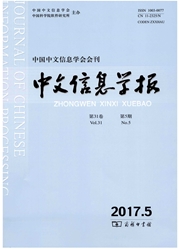

 中文摘要:
中文摘要:
在分析汉语标点符号用法和句法功能的基础上,本文提出了一种新的面向汉语长句的层次化句法分析方法。这种方法和传统的不考虑标点符号的一遍分析方法的主要区别在于两个方面:第一,利用部分标点符号的特殊功能将复杂长句分割成子句序列,从而把整句的句法分析分成两级来进行。这种“分而治之”的策略大大降低了在传统的一遍分析方法中同时识别子句或短语之间的句法关系以及子句和短语内部成分的句法关系的困难。第二,从大规模树库中提取包含所有标点符号的语法规则和相应概率分布信息,有利于句法分析和歧义消解。实验证明我们的方法与传统的一遍图表(chart)分析方法相比,能够大大减少时间消耗和歧义边的个数,并且提高了复杂长句分析的正确率和召回率约7%。
 英文摘要:
英文摘要:
Based on the analysis of the usage and the syntactic function of Chinese punctuations, this paper proposes a new hierarchical approach to parse the long Chinese sentences. In traditional parsing approaches, the parsing procedure is performed in an one-level way and the punctuation marks are not specially treated. Correspondingly, in our approach, the complex long Chinese sentences are broken into sub-sentences or units (say ' units' hereafter) by using punctuation marks with special functions, so that the original whole sentence is parsed unit by unit. This idea of ' divide-and-conquer' greatly reduces the difficulty in the traditional parsing approaches to recognize the syntactic relationship between the sub-sentences and phrases or inside the sub-sentences or phrases. And also, in our approach, the grammatical rules with punctuation marks and their probabilities are extracted from the large scale treebank, which are very beneficial to the syntactic disambiguation. Our experimental results have shown that comparing with the traditional Chart parsing algorithm, our approach can significantly reduce the time consumption and the numbers of ambiguous edges, and get about 7% of the correct rate and the recall rate increasing while parsing long Chinese sentences.
 同期刊论文项目
同期刊论文项目
 同项目期刊论文
同项目期刊论文
 期刊信息
期刊信息
